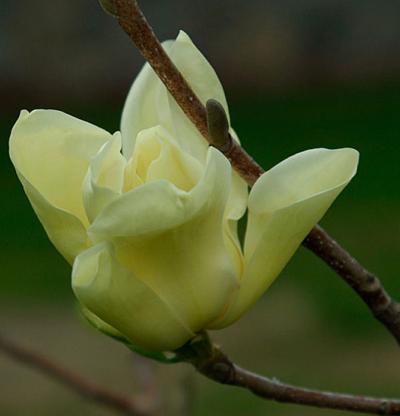





 Magnolia (Magnolia 'Elizabeth')
mag-NO-lee-ah
Genus:
Magnolia
Few species can match the elegant drama of this specimen in full bloom. It has luminous, pale yellow, cup-shaped flowers to 6 inches across that seem to glow on the bare branches in late spring.
Care:
Grow in moist, well-drained, preferably acidic to neutral soil in sun or partial shade; magnolias do not tolerate wet feet. Magnolia flowerbuds are susceptible to late-season frosts; shelter large-leaved species from windy locations. Prune trees and deciduous shrubs in late winter or late summer to prevent bleeding of sap; prune minimally to maintain a healthy framework.
Propagation:
Sow seeds in autumn or stratify to hasten germination. Root softwood cuttings in early summer. Magnolias can be layered in early spring, grafted in winter, and propagated by bud in summer.
Problems:
Bacterial leaf spot, spot anthracnose, canker, dieback, butt rot, powdery mildew, anthracnose, fungal spots, weevils, snails, scale insects, thrips, planthoppers.
Magnolia (Magnolia 'Elizabeth')
mag-NO-lee-ah
Genus:
Magnolia
Few species can match the elegant drama of this specimen in full bloom. It has luminous, pale yellow, cup-shaped flowers to 6 inches across that seem to glow on the bare branches in late spring.
Care:
Grow in moist, well-drained, preferably acidic to neutral soil in sun or partial shade; magnolias do not tolerate wet feet. Magnolia flowerbuds are susceptible to late-season frosts; shelter large-leaved species from windy locations. Prune trees and deciduous shrubs in late winter or late summer to prevent bleeding of sap; prune minimally to maintain a healthy framework.
Propagation:
Sow seeds in autumn or stratify to hasten germination. Root softwood cuttings in early summer. Magnolias can be layered in early spring, grafted in winter, and propagated by bud in summer.
Problems:
Bacterial leaf spot, spot anthracnose, canker, dieback, butt rot, powdery mildew, anthracnose, fungal spots, weevils, snails, scale insects, thrips, planthoppers.
Copyright © www.100flowers.win Botanic Garden All Rights Reserved